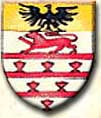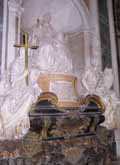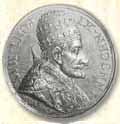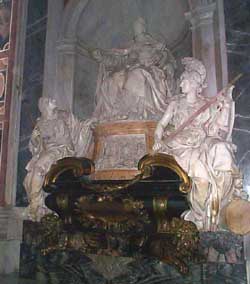 |
| Grottoes
Vatican City Colonnade Saints Floorplan #2 |
| Altars
Monuments The History |
| Related
Sites Innocent XI St Sebastian Altar |
|
The figure of the Pope is flanked by Faith and Fortitude. The bas-relief shows the victory over the Turks in Vienna in 1683. Innocent XI was beatified Oct. 7, 1956, his feast day is August 13. The pope's body is visible under the St. Sebastian altar on the opposite side of the basilica. |
 |
 |
From: 'St. Peter's - Guide to the Basilica and Square'
On the left, towards the central nave, is the funeral Monument of Innocent
XI (1676-1689), the work of the French sculptor Pierre Etienne Monnot.
The Pontiff, making a solemn, oratorical gesture, is seated on the throne
set above a sarcophagus, in giallo antico marble. A bas-relief on the
urn of John Sobieski, shows the Victory over the Turks in Vienna in 1683.
From:
'St. Peter's Basilica - A Virtual Tour' by Our
Sunday Visitor
Facing it is the Monument to Innocent XI, executed by P. E. Monnot who,
inspired equally by Algardi and Bernini, created a work with a harmonious
compositional unity. The bas-relief shows the Liberation of Vienna from
the Turks in 1683 thanks to Sobiesky, which undoubtedly was a decisive
episode in the history of Europe.
The two metal lions sustaining the black marble urn overlaid with bronze refer to the arms of the Odescalchi family to which the Pope belonged. He is solemnly represented above as if talking to the people. The two allegorical figures do not represent, as is often repeated, Religion and Justice but rather, as rightly indicated by R. U. Montini in his "Tombs of the Popes" (1957), Faith and Fortitude, symbolizing the Christian virtues shown by the Pope in his struggle against the Turks, with prayer, diplomacy and huge financial aid, though a donation of 5 million florins.
Other Sources
Innocent XI was elected pope on Sept. 21, 1676, against the opposition
of King Louis XIV of France, who proved to be an enemy of ecclesiastical
privileges during Innocent's pontificate. He inherited an insolvent papal
treasury but averted bankruptcy through wise taxation, rigid economizing,
and financial support from Catholic powers. Innocent aided the war against
the Turks by subsidizing King John III of Poland and the Holy Roman emperor
Leopold I in a campaign that led to the relief of Vienna (1683) from the
Turkish siege.
In doctrinal matters, Innocent sympathized somewhat with the Jansenists, followers of a nonorthodox ecclesiastical movement created by Bishop Cornelius Jansen of Ypres, which opposed Louis's religious policies. Although a friend of Miguel de Molinos, the Spanish mystic and proponent of the doctrine of Christian perfection known as Quietism, Innocent allowed Molinos to be arrested by the papal police and tried for personal immorality and heresy. He was sentenced to life imprisonment, and Innocent condemned his propositions in 1687.
Innocent is considered the outstanding pope of the 17th century, largely because of his high moral character. In a time of frequent papal corruption he was free from nepotism and his integrity was unquestioned. He was beatified by Pope Pius XII on October 7, 1956.


